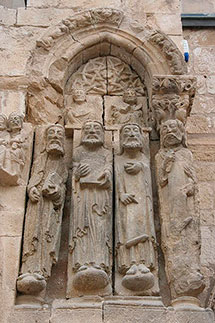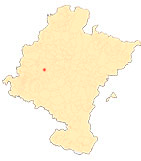La Portada de San Miguel de Estella
Apostolate and marginal elements
The figurative display of the New Testament in the tympanum, archivolts and capitals is completed by the somewhat marginal presence of the apostolate, for which the sides of the spandrels were reserved. It is made up of twelve figures of unequal format and postures, as eight are shown standing and four seated. The artists only wanted to identify two of them by their physiognomy: the one closest to the tympanum on the left of the viewer holds the keys in his hand, an unmistakable attribute of Peter, while the one closest to section on the right group has a large bald head, which makes it possible to identify him with Paul. But both Peter and Paul hold phylacteries in their hands, as do three other standing apostles, while the remaining three carry books. All the faces are bearded and not very expressive. The other four apostles are seated under the arches. The removal of the Baroque portico decades ago left inscriptions with the names of Thaddeus and Simon visible, which put an end to doubts about their identity. The interiors of the high arches are completed by animal figures (reminiscent of late Romanesque reliefs from Santiago de Compostela) and an eight-pointed star. The capitals are decorated with griffins and lions. The animal theme extends to the chambranes.
In the narrow strip between the apostolate and the archivolts there is a relief on each side, with a pair of crowned figures, in one case kneeling, who seem to want to fill in the issue of twenty-four elders (eighteen are depicted in the archivolts, so that even counting both pairs they do not add up to twice a dozen).
Two mouldings run horizontally across the doorway at the height of the crests, both of the capitals that support the archivolts and of those that support the lateral arches. The basic motif of the ornamentation is the scroll of fleshy leaves. In selected places, figures apparently alluding to the characters in the capitals are incorporated, such as the showy flowers on the Virgin in the capitals of the Annunciation and the Epiphany, the vermin on Herod in the scene in which he orders the slaughter of the innocents, or the fighting monsters on the capitals with young combatants facing dragons.
The corbels supporting the tympanum depict terrifying-looking androphagous lions, topic not unusual in late Romanesque Hispanicism.












